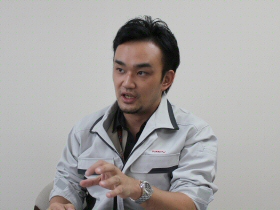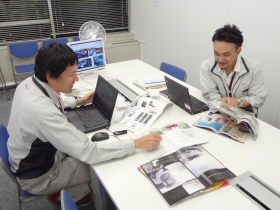Product Planning
This section covers one of NMKV’s core business pillars – the product planning of NMKV’s vehicles which stands on a par with the product development. What kind of tasks are there to produce a pair of Kei-cars from a single product plan, while securing each Brand’s identity of Nissan-ness or Mitsubishi-ness. We set up a talk session with Masaki Izumi (Nissan affiliation) and Hiroki Kasai (Mitsubishi affiliation) of Product Planning Group and listened to their stories.

▲Kasai and Izumi (left to right)
Kei-Car product planning and how we work
- Tell us about your background and work experience.
Kasai:After I joined Mitsubishi Motors, I worked in its experimental department for about three years. In the midstream I was dispatched to a sales division and worked as a sales representative. I spent seven years in the Product Planning department, working exclusively on the product planning of Kei-cars.

- I heard that Izumi-san’s career is quite extraordinary.
Izumi: I think so. I was originally interested in the field of product marketing. My first job was a sales representative in a mobile carrier which I worked for three years, and then worked in its product planning department for three more years. After that I joined Nissan Motor through a mid-career recruitment and was assigned to the product planning team which tasks were mainly focused on developing commercial vehicles sold overseas. Among the projects I got involved are New York Yellow Cab whose competition Nissan won and made the news among the industry, and China’s microcar (also known as “微型”) product planning whose specifications are unique to China. All the while I have been working for unique product planning projects of unorthodox vehicles such as commercial ones across the overseas markets from Asian, European, and to North and South American countries. I was finally assigned to a domestic department in Japan, which task was, again, to deal with Kei-cars whose standard is Japan-specific. So yes, I think my career is somewhat unusual.
- Although you two are working in the same Product Planning department, you have followed quite different career paths. Tell us about your task and goal as a team in Product Planning.
Kasai:In a nutshell, our task is to create a basic concept for a new car product. Specifications including but not limited to range of car grades and type of equipment are to be fixed to materialize the concept. Then we hand them over to the Product Development team. We design and conduct market surveys to collect and analyze necessary data for a viable concept. We stand in the middle of sales forces and development teams to help the former to clarify their requests and the latter their issues for better coordination to finalize the specifications, bringing all ideas, including ourselves, together into one vehicle model.
- Is there any difference in Kei-car product planning compared to other models?
Izumi:There in the market still remains an assumption of Kei-cars that they “cost little and little esteemed”; after I joined NMKV, I realized that such assumption is not true. Today, customers and car manufacturers are increasingly diversifying. It always surprises us when we review customer feedbacks that we collect from the market. In fact, Kei-cars are as good as regular vehicles in terms of machine capabilities. They also have plenty of equipment available. There are a wide range of setups including turbocharger, all-wheel drive, etc in our toolbox.
Kasai:In the past, there was common interpretation of Kei-cars that they were better suited for the female customers and elder generations. Such interpretation had been reflected to the real customer demographics. But now Kei-cars have penetrated into wider range of customers including male drivers. Although Kei-cars have limited capabilities due to the restricted specification unique to the Kei-car standard, there are Kei-car models today equipped with advanced functions almost as good as regular vehicles or even better. It is very exciting as we unfold untapped potential of Kei-cars in the product planning.
Izumi:As I always wanted to do the work related to manufacturing, it makes me really happy to see the cars which I’m involved in the planning drive on the road. While I was working in the mobile carrier, I had somewhat discontent toward the materialization process of my own ideas being transformed into actual products by the hands of manufacturers. It is special to see the cars running in my home country’s streets in comparison with the cars running streets overseas.
NMKV’s leadership for “One Voice”
- Tell us about the challenges you face in the actual work of product planning.
Izumi:Our task is to summarize different requests from tow parent companies into an “One Voice” concept. This is a huge difference when compared to an ordinary process of product planning and is the toughest part of our job.

Kasai:As DAYZ and eK WAGON were the first models, we struggled a lot to create a single product plan because their target customers, market segments and car concepts are entirely different. It was lucky that both companies shared the goal to “create a new standard for Kei-cars”. Other than that, there were so many differences between two companies that made us really flabbergasted. As we had to work in between two organizations, I felt like we were left alone in a vast desert. I can’t help wondering “what should we do now?”
Izumi:So, we learnt a lesson. In the second release we made Kei-cars such as DAYS ROOX and eK SPACE. Although two companies sustained their own target customers and market segments, NMKV was then allowed to take the initiative to create the base concept. I recall that the efficiency improved drastically thereafter.
Kasai:Nissan and Mitsubishi adopt a different set of processes in their workflow in the first place. Based upon this understanding, we have been working to find a way to “pick the best” of two companies for the task of Product Planning. Through such efforts, we have learnt from many case studies. I think we have finally reached a stage where we can actually standardize the workflow and other sub-processes and promote smoother operations.
- Is there a specific example of how NMKV proposes a solution out of the difference that lies between two companies?
Izumi:Yes. Think of proposing a new color by making minor changes to the existing models. Two companies want different set of colors in their lineup. If we were to accept these requests as they are, it would require a large number of new colors, a heavy burden to the production team as well. This is the point where we start. We go back to the original concept of relevant models and come up with the selected set of color variations that match such concept. We will explain our ideas to two companies to reach a solution deemed the best for all.
Kasai:We are not just a facilitator of the meetings. It is about listening to their requests and understanding them and is about leading everyone to the best possible solution. That’s the work we do here.
Navigate product design and development teams toward the goal to properly reflect “customer needs into a product”

▲A meeting scene
-Tell us hardship you encountered during the first and second releases.
Izumi:In the beginning, it was especially hard for me to talk with product design and development teams. They often told me, “Product Planning only asks what they want”. Well, they keep saying that ever since. But we are also confident that we Product Planning are the ones most close to our customers, and the ones who best understand customer needs. We try to reflect such customer voices as the core motivation and negotiate with respective teams with patience. Product Planning and Product Development teams are both in the same Okazaki branch and we meet each other quite often. I believe we got used to each other now, and our opinions and requests are better listened.
Kasai:We had many discussions while each of us having own enthusiasm. I think that Product Development and Product Planning have come to have a common awareness that our goal is to materialize nothing other than the customer needs. Today, the communication between us is much more intensive, so that we can delve deeply.
Izumi:I pay great respect to the abilities of NMKV product design and development teams. Especially the ability to create a specific solution to unreasonable demands. Our job relies on them a great deal.
- This is the last question. As the Product Planning member, what kind of car do you want to produce? Tell us if you have any personal goals.
Kasai:Against many competitors, I want to make a Kei-car that is unique and original, that only NMKV can produce. Despite various restrictions inherent to a Kei-car, but I definitely want to do it.
Izumi:I want to make a Kei-car that can contribute to the branding strategy of my parent company. Cost performance and sales power are of course important factors when creating a vehicle, but I want to create a Kei-car as a dream car. A car that children and everyone would aspire to buy.
- Thank you for your time.
The talk session was held in May 2014. The positions they assume and affiliation they take in this article are as of at the time of the session.






